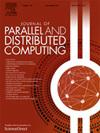SpecSeq++: A high parallel boundary matrix reduction to support real large-scale point clouds
IF 3.4
3区 计算机科学
Q1 COMPUTER SCIENCE, THEORY & METHODS
引用次数: 0
Abstract
The boundary matrix serves as a crucial representation for computing the persistence diagrams, which is a typical topological data analysis method, and its reduction is the most central and time-consuming step. However, most of the current methods do not have a high degree of parallelism. Therefore, a fully GPU-parallelized boundary matrix reduction algorithm, denoted by SpecSeq++, is proposed. It introduces some novel methods, such as the high-dimension guided clearing theorem, the new method for pivot determination within blocks, and a novel dynamic block partition strategy to mitigate load balancing issues and the long-tail effect in intra-block parallel computation. Based on the experiments with three types of boundary matrices of different sizes and different complexes, the results show that SpecSeq++ has better performance, and in the best-case scenario, SpecSeq++ performs more than 700x better than phat-twist optimized with the dualization while its average GPU memory overhead is only twice that of the serial method. It provides strong support for the practical application of topological data analysis on real point cloud data. Codes are available at https://github.com/BuptCIAGroup/SpecSeqPlusPlus.
specseq++:一个高并行边界矩阵简化,支持真正的大规模点云
持久化图是一种典型的拓扑数据分析方法,边界矩阵是计算持久化图的重要表示形式,而边界矩阵的约简是计算持久化图最核心、最耗时的步骤。然而,目前的大多数方法都没有高度的并行性。为此,提出了一种完全gpu并行化的边界矩阵约简算法,命名为specseq++。引入了一些新的方法,如高维引导清除定理、新的块内支点确定方法和新的动态块划分策略,以缓解块内并行计算中的负载均衡问题和长尾效应。通过对三种不同大小和不同复杂度的边界矩阵进行实验,结果表明,specseq++具有更好的性能,在最佳情况下,specseq++的性能比采用对偶化优化的pht -twist性能提高700倍以上,而其平均GPU内存开销仅为串行方法的两倍。为拓扑数据分析在真实点云数据上的实际应用提供了有力的支持。代码可在https://github.com/BuptCIAGroup/SpecSeqPlusPlus上获得。
本文章由计算机程序翻译,如有差异,请以英文原文为准。
求助全文
约1分钟内获得全文
求助全文
来源期刊

Journal of Parallel and Distributed Computing
工程技术-计算机:理论方法
CiteScore
10.30
自引率
2.60%
发文量
172
审稿时长
12 months
期刊介绍:
This international journal is directed to researchers, engineers, educators, managers, programmers, and users of computers who have particular interests in parallel processing and/or distributed computing.
The Journal of Parallel and Distributed Computing publishes original research papers and timely review articles on the theory, design, evaluation, and use of parallel and/or distributed computing systems. The journal also features special issues on these topics; again covering the full range from the design to the use of our targeted systems.
 求助内容:
求助内容: 应助结果提醒方式:
应助结果提醒方式:


